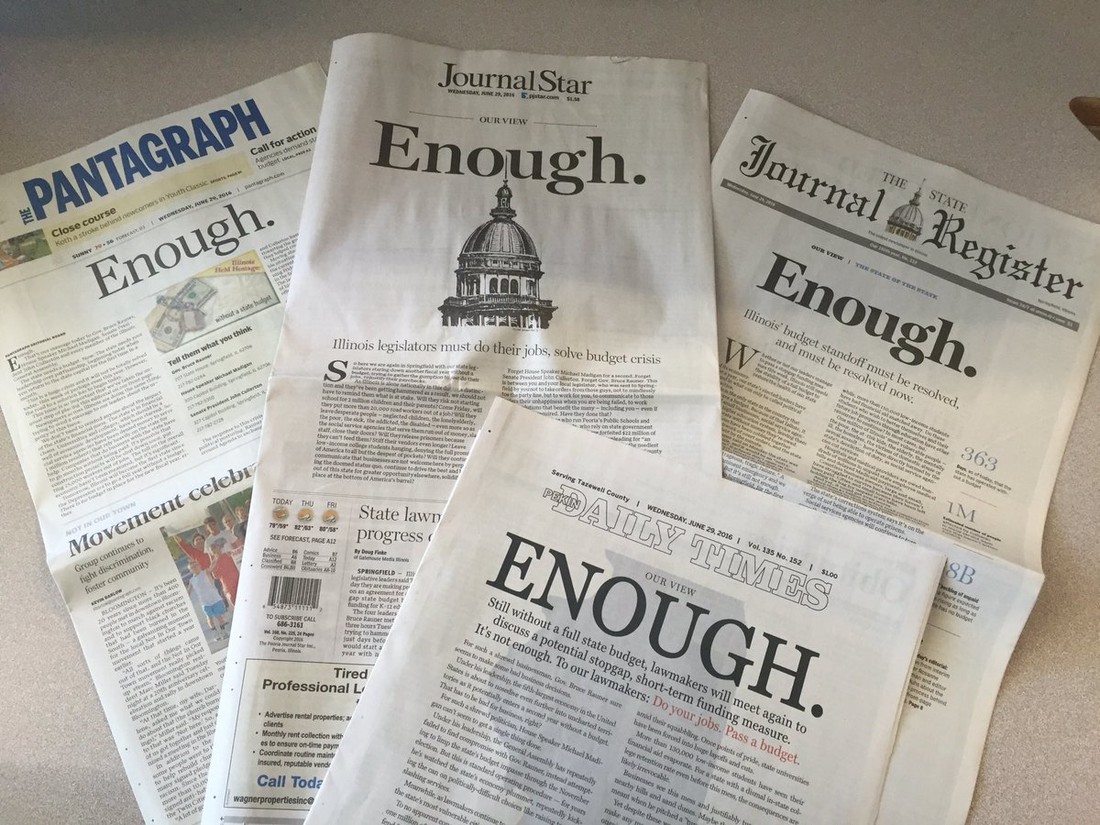Could a front-page editorial end the budget crisis in Illinois?
The power of the press was demonstrated last week in Illinois when the General Assembly passed stopgap budget measures – on the final day possible – that will keep K-12 schools open, benefit the state's colleges and social services, and provide funding to keep state government operations afloat. The stopgap measures came one day after more than 60 newspapers joined the State Journal-Register in a coordinated editorial effort (with many of the editorials on the newspapers' front pages) declaring "Enough" and demanding that a budget be passed.
In the following Q&A column by Jean Hodges, senior director of content for GateHouse Media, Editor Angie Muhs explains the process the editorial board took to decide to run a full-page editorial on A1, along with an explanation for readers that runs on the inside editorial page.
Reprinted from GateHouse Newsroom
By Jean Hodges, senior director of content, GateHouse Media
Have a huge issue that demands a strong voice from your newsroom? In print, that advocacy is normally reserved for your Opinion page. But if the issue is big enough, newsrooms have begun to run editorials on the front page. From Fix This Now, the Religious Freedom Restoration Act editorial in the Indianapolis Star last year, to the New York Times' first A1 editorial since 1920, calling for an end to the gun epidemic, we've seen editorials out front.
In fact, Newseum explored the resurgence of what was once a tradition, and Poynter weighed in this year with some advice: Keep editorials on A1 rare.
If you're going to advocate for a position on your front page, The State Journal-Register in Springfield, Ill., picked a good one. Illinois is the only state in the union that has operated without a budget for a year. In its front-page editorial, entitled "Enough," The SJ-R writes:
Gov. Bruce Rauner said on Monday the state was on the verge of crisis, and that it would be an "outrageous, tragic failure" if schools don't open on time this fall.
With all due respect, Governor, the state is already in crisis and the budget standoff has already been an "outrageous, tragic failure."
Editor Angie Muhs didn't stop with running an editorial on the front page of the newspaper in the state capital. The editorial takes up the entire front. Muhs also rounded up more than 60 other newspapers in the state to run the SJ-R's editorial or one of their own on the budget impasse. Dozens of the editorials are running on front pages June 29.
In this Q&A, Muhs explains the process the editorial board took to decide to run the editorial on A1, along with an explanation for readers that runs on the inside editorial page.
Can you give us a little background on the Illinois budget stalemate and your timing of the front-page editorial?
Last year, during the 2015 legislative session, the governor and General Assembly failed to pass a budget, meaning the state has operated without one since July 1, 2015. Thanks to court rulings, some services are still being paid – most notably state workers' salaries – but most funding has been shut off. Again, the governor and General Assembly failed to pass a budget during the regular 2016 session, which ended May 31. Lawmakers return on June 29 – the day our editorial runs – for a last-ditch effort at a stopgap bill that would at least fund services for the short-term.
It's still unusual for newspapers to put an editorial on the front page, let alone to use the whole front page. How did you decide to go full out for this issue? Who came up with "Enough?"
The State Journal-Register in Springfield, Ill., used its entire front page to call for state legislators to pass a budget.

What started our conversation was a recent panel discussion on the budget impasse impact; several social service providers were asked if they thought the governor and legislative leaders were listening or cared about their plight. They said pretty flatly they don't think they care. We were talking about the impasse on Wednesday of last week, about the next editorial we'd be writing, and our frustration was what we could do differently to bring attention to this crisis or try to force action. We started riffing first about putting the editorial on the front page, then about making it the whole front page. We decided to see if Peoria and Rockford (two other GateHouse papers) were interested, then realized we ought to approach all of Illinois' GateHouse papers. From there, we thought it was worth throwing the idea out to other Illinois papers outside GateHouse. "Enough" bubbled up quickly as the one word that brought clarity to the severity of the situation.
Was there any debate internally about whether an editorial on the front was appropriate? Have you done this before?
Longtime staffers say they don't remember the SJ-R doing a front page editorial in at least the last 20 years. We felt a front page editorial will be an attempt to call attention to the severity of the crisis and a need for state leaders to get a budget passed.
Why did you decide to involve other newspapers in the state? How did you go about doing that?
The budget crisis is affecting ordinary people and businesses large and small all over the state. While editorial boards might disagree on where the blame lies or the causes, our sense – which has been borne out by the reaction we've gotten from other papers – was that we could all at least agree that we've hit a crisis point and a budget has to be passed. Having newspapers all over the state making that point amplifies that voice.
How are you explaining this to your readers? Why is that important to you? Do you think readers will push back?
We plan to publish a column from Rosanne Cheeseman (interim publisher and editorial board member at The State Journal-Register) and me on Wednesday's normal editorial page, explaining why we felt the issue was worth highlighting on the front page.
GateHouse's Center for News and Design in Austin has done a great job – especially G.W. Babb and Dhyana Sansoucie, who coordinated getting the page onto other GateHouse Illinois sites – in coming up with a striking presentation that's clearly labeled "Our View," so I think readers will understand what's going on.
We've focused not on assigning blame – there's plenty of it to go around – but on laying out why this is a crisis and issuing a challenge to our elected officials to fix it.
We know from our letters to the editor that readers are frustrated; they want a solution.
As the newspaper in the state capital, what responsibility do you think you have to lead an effort like this?
We're obviously closer to it than anyone else, and so Springfield has been hit hard by the impasse's effects. State government coverage is really one of the SJ-R's hallmarks and signature efforts, and that's true of our editorial page as well.
Ultimately, what is your goal?
The primary goal is to elevate the urgency and put pressure on elected officials to get the job done. Having other newspapers also take the dramatic step of front-page editorials helps amplify that voice. We want to be an advocate for the state residents who are being affected by government's inaction.
Anything else you want us to know? Advice for other newsrooms?
A lot can come out of conversations that start with, "What if?" Don't be afraid to think big and think differently. Together we are stronger and our voice is more powerful if we leverage that strength for the good of the state.
As senior director of content, Jean Hodges develops strategy and works with newsroom leaders on digital transformation, from newsroom structure to using analytics to inform news decisions. As journalists face myriad challenges, the best are experimenting with new ways to draw readers in, while fearlessly tackling watchdog reporting and sticking up for the underdog. Hey, there's hope for us yet.









